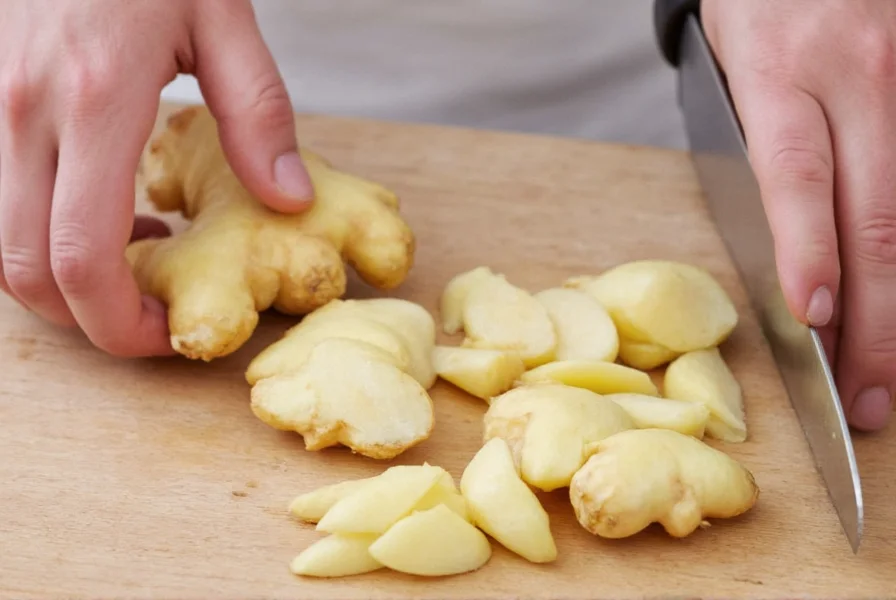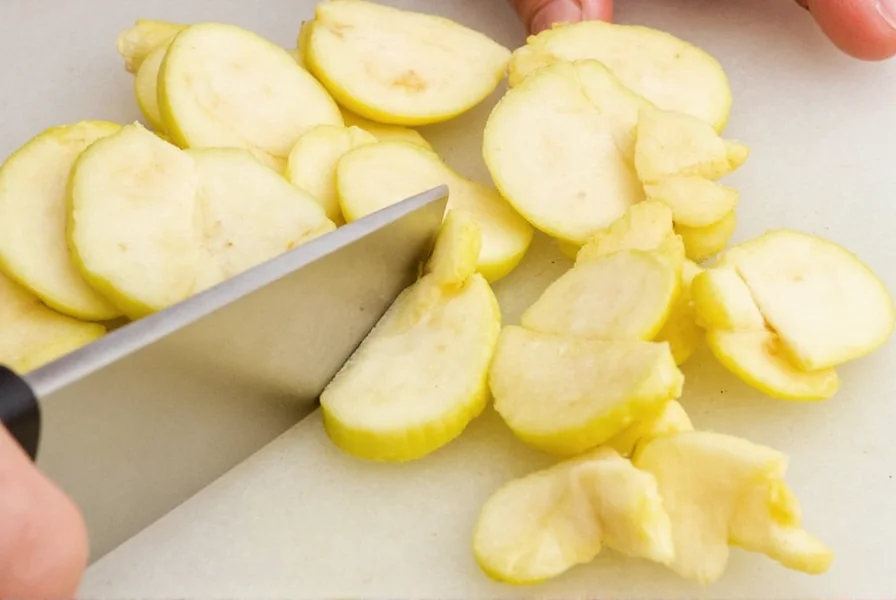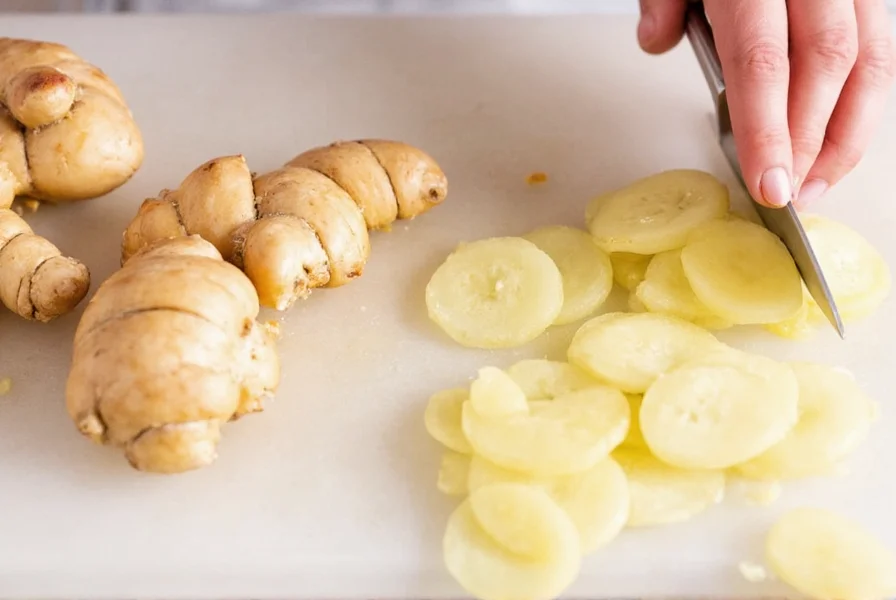Slicing ginger properly transforms both the flavor release and texture in your dishes. Many home cooks struggle with ginger's fibrous nature, leading to uneven pieces or wasted product. This guide provides professional techniques that ensure perfect ginger slices every time, whether you're preparing Asian cuisine, making teas, or adding flavor to baked goods.
Essential Tools for Slicing Ginger
Before learning how to slice ginger, gather these kitchen essentials:
| Tool | Best For | Alternative Options |
|---|---|---|
| Sharp chef's knife (8-inch) | Precise, uniform slices | Santoku knife |
| Spoon (tablespoon) | Peeling without waste | Vegetable peeler |
| Stable cutting board | Safe, consistent slicing | Any non-slip surface |
| Freezer (optional) | Firming up ginger for easier slicing | Refrigerator |
Professional chefs prefer using a spoon to peel ginger rather than a traditional peeler because it follows the root's natural contours, minimizing waste of the valuable flesh beneath the thin skin.

Step-by-Step Ginger Slicing Technique
1. Selecting and Preparing Your Ginger
Choose firm, smooth ginger with tight skin and no soft spots. Refrigerated ginger becomes harder to slice, so let it sit at room temperature for 15-20 minutes before preparation. For particularly fibrous ginger, freeze for 15 minutes to firm it up—this professional trick makes slicing significantly easier.
2. Proper Peeling Method
Hold a tablespoon by the handle and use the rounded edge to scrape away the skin. Work with the ginger's natural curves rather than against them. This technique removes only the papery skin while preserving maximum flesh—typically saving 20-30% more usable ginger compared to traditional peelers.
3. Cutting Technique for Perfect Slices
Place the peeled ginger on its side. Using a sharp knife, cut crosswise against the grain (perpendicular to the fiber direction) for the most tender slices. For most applications, aim for 1/8-inch thickness:
- Thin slices (1/16-inch): Ideal for tea, delicate sauces, or raw applications
- Standard slices (1/8-inch): Perfect for stir-fries and most cooked dishes
- Thick slices (1/4-inch): Best for pickling or robust stews
Keep your fingers curled safely away from the blade and use a rocking motion with the knife for consistent results. Professional cooks maintain blade contact with the cutting board throughout the motion for maximum control.

Advanced Ginger Slicing Methods
Julienne (Matchstick) Technique
For dishes requiring fine ginger strands:
- Slice ginger into 1/8-inch thick rounds
- Stack 3-4 slices
- Cut lengthwise into thin matchsticks
- Perfect for stir-fries, garnishes, or salad toppings
Slicing Frozen Ginger
When working with frozen ginger (great for preserving excess):
- Remove from freezer and let sit 2-3 minutes
- Use a serrated knife for cleaner cuts
- Slice immediately before it thaws completely
- Ideal for adding precise amounts to recipes without thawing entire root
Common Ginger Slicing Mistakes to Avoid
Even experienced cooks make these errors when learning how to properly slice ginger:
- Slicing with the grain: Creates tough, stringy pieces that don't release flavor properly
- Using a dull knife: Crushes rather than cuts ginger, releasing too much juice and altering texture
- Improper thickness: Too thick = uneven cooking; too thin = burns easily
- Peeling too deeply: Wastes up to 30% of usable ginger when using traditional peelers
Storing Sliced Ginger Properly
Maximize freshness of your sliced ginger:
- Store in airtight container with damp paper towel
- Refrigerate for up to 2 weeks
- Freeze slices between parchment paper for longer storage
- Add a splash of sherry to container for enhanced flavor preservation
Properly stored sliced ginger maintains optimal flavor release for cooking applications better than whole ginger that's been sitting for weeks.
FAQ: Ginger Slicing Questions Answered
What's the best knife for slicing ginger?
An 8-inch chef's knife provides the perfect balance of control and precision for slicing ginger. The curved blade allows for the rocking motion that creates uniform slices. For smaller ginger pieces, a 5-inch utility knife works well. Always ensure your knife is sharp—dull blades crush ginger fibers rather than cutting cleanly.
Can I slice ginger without peeling it first?
Yes, you can slice unpeeled ginger in certain applications, particularly when making ginger tea or stocks where the ginger will be strained out. However, for most cooking applications where ginger remains in the dish, peeling is recommended as the skin can be tough and fibrous. The spoon peeling method removes only the thin outer layer while preserving maximum usable ginger.
Why does my ginger keep slipping while I slice it?
Ginger slips when your cutting board isn't stable or when the ginger piece becomes too small. Place a damp towel under your cutting board to prevent movement. For small ginger pieces, cut a thin slice from one side to create a flat surface that won't roll. Professional chefs often partially freeze ginger for 15 minutes before slicing, which firms it up and reduces slipping.
How thin should ginger slices be for stir-fry?
For stir-fry applications, 1/8-inch thick slices work best. This thickness allows the ginger to cook evenly without burning while releasing optimal flavor into the dish. If you're adding ginger early in the cooking process, slightly thicker slices (3/16-inch) prevent burning. For quick-cooking stir-fries where ginger goes in at the end, thinner slices (1/16-inch) work better as they'll cook through in the residual heat.
What's the difference between slicing and grating ginger?
Slicing ginger creates distinct pieces that provide bursts of flavor throughout a dish and maintain texture, while grating releases more juice and distributes flavor more evenly. Sliced ginger works best for dishes where you want to taste distinct ginger pieces (like stir-fries), while grated ginger is ideal for marinades, dressings, or baked goods where you want uniform flavor distribution without noticeable pieces.











 浙公网安备
33010002000092号
浙公网安备
33010002000092号 浙B2-20120091-4
浙B2-20120091-4